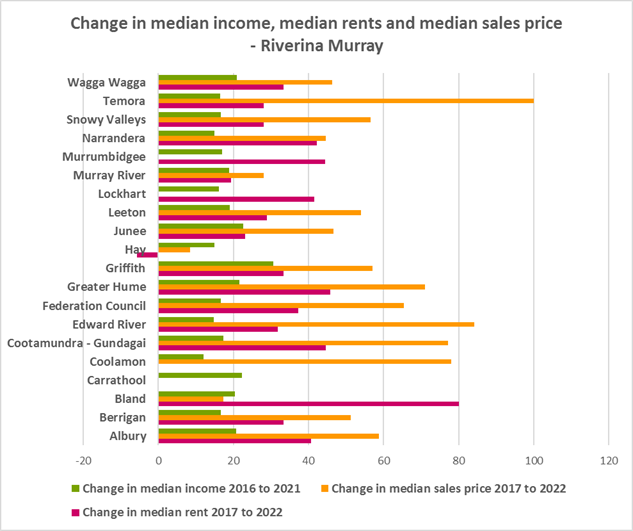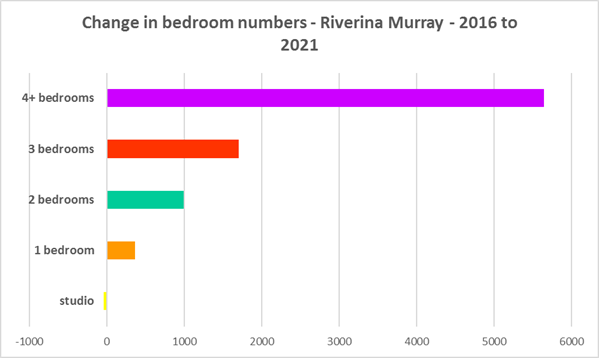Housing Market Snapshot - Riverina Murray region
The Housing story in Riverina Murray
The Riverina Murray region is comprised of the 20 local government areas of Albury, Berrigan, Bland, Carrathool, Coolamon, Edward River, Federation, Greater Hume, Griffith, Gundagai, Hay, Junee, Leeton, Lockhart, Murray River, Murrumbidgee, Narrandera, Snowy Valleys, Temora and Wagga Wagga. The region covers an expanse of 114,309 square kilometres or 14.3% of NSW. It includes most of the region adjacent to the Victorian border, as well as from the Murrumbidgee River to the inland plains of Hay and Carrthool, with very diverse natural landscapes, large regional centres and small towns.
Infrastructure Australia’s report “2022 Regional Strengths and Infrastructure Gaps” splits the region between the Murray region and the Riverina. The report notes that the Murray region contributes to the agricultural, manufacturing and renewable energy sectors, with strategic transport connections between states. Planning is underway for the South-West Renewable Energy Zone which is expected to deliver economic benefits and further unlock energy generation capacity in parts of this and surrounding regions. It notes that the Riverina is home to significant education and research institutions set amongst a network of major service and employment centres, including Wagga Wagga and Griffith. The Riverina has also seen growth of value-added manufacturing and renewable energy. In both the Riverina and the Murray, Infrastructure Australia nominates the availability, affordability and diversity of housing as a key infrastructure gap.
What’s the housing demand?
The Riverina Murray region had a population of 283,060 at the 2021 Census (up by 5.4% from 268,575 in 2016). However, not every LGA in the region experienced population growth over this period. Bland, Edward River, Hay, Murrumbidgee, Narrandera and Temora all experienced a loss of population over this period, while all the remaining LGAs in the region saw population growth. Over half (53.3%) of the Region’s population is concentrated in Wagga Wagga, Albury and Griffith.
The median age of the population of the Riverina Murray LGAs at the 2021 Census ranges between 35 years (Wagga Wagga) and 52 (Berrigan), compared to the average for the Rest of NSW of 43 years. As a region, Riverina Murray has a higher proportion of 0-4, 5-14, 15-19, 20-24 and 25-34 year olds than the Rest of NSW average, the same proportion of 35-44 year olds and lower proportions of older age groups. However, not every LGA in the region follows this pattern, with for example, Berrigan, Bland, Coolamon, Cootamundra-Gundagai, Edward River, Federation, Lockhart, Murray River, Narrandera, Snowy Valleys and Temora having higher proportions of cohorts aged over 55 years than the Rest of NSW average.
The diversity of age groups requires a range of different housing to meet the needs of the community throughout the housing life cycle. However, the higher median age and higher proportions of older age cohorts in some of the region’s LGAs indicates that there is a need for housing to suit older residents. Increasingly this will be the case in all the Riverina Murray LGAs as the number in older age groups grows.
For the Riverina Murray region as a whole, there are equal proportions of lone person households and couple families without children (27.2%), representing the largest two household types. Consequently, although there should be plenty of housing suitable for families of different sizes, there is also a need for a variety of dwellings with different bedroom numbers to suit couples and single person households.
At the 2021 Census, low income households comprise the largest proportion of all households in the Rest of NSW, in the Riverina Murray as a whole (with 48.9%) and in all but two of the region’s LGAs (Albury and Carrathool were the exceptions). Across the region the proportion of low income households ranges from 37.1% in Carrathool to 61.9% in Narrandera. Between 2016 and 2021 the number of low income households increased in the Riverina Murray region and most but not all LGA’s. Moderate income households comprise 22.3% of households in the Riverina Murray as a whole and high income households 28.8%.
What’s happening in the market?
Historically much of this region has been more affordable for rental and purchase than the average for the Rest of NSW. However, median rents and sales prices have increased, the proportion of affordable rental and purchase declined for both very low and low income households in the majority of LGAs in the region and most LGAs experienced a reduction in affordable private rental.
Between 2017 and 2022 median rents increased across the region, with the exception of Hay which declined by -5.6%. In the remaining LGA’s, increases ranged between 19.4% in Murray River and 80.0% in Bland.
It is likely that there have been significant impacts on the region from the floods in late 2022, affecting the availability and affordability of rental housing, particularly in the worst hit areas.
At June 2021 the proportion of very low income households in rental stress in the Riverina Murray region averaged 86.3%, with the proportion varying from 91.8% in Albury to 64.6% in Bland. For low income rental households the proportion in stress in the region was 49.0%, ranging from 56.9% in Wagga Wagga to 20.4% in Bland.
The region experienced a significant decline in affordable rental bonds lodged between 2017 and 2022, and consequently loss of affordable housing – with -600 or -29.1% fewer affordable rental bonds lodged.
While the region is generally more affordable than the average for the Rest of NSW, purchase affordability for very low income earners in the Riverina Murray region has declined since 2017 and also for low income households in some LGAs. In 2021 36.5% of very low and low income purchasers were in stress across the region, well below the Rest of NSW average of 43.9%. There are significantly more very low and low income renters in stress than very low and low income purchasers.
What’s happening with supply – and is it a good match?
The overwhelming majority of housing in the region was built at a time when couple families with children were the dominant household type. Now smaller households (couples and single person households) predominate and are expected to continue to increase across the region, particularly as the population ages.
Consequently the region also has little variation in the number of bedrooms per dwelling. Across the Riverina Murray 42.1% of dwellings have three bedrooms and a further 36.2% have four or more bedrooms, totalling 78.4%. Only 0.3% of homes are studios, 2.0% have one bedroom and 16.6% have two bedrooms.
Given that lone person and couple only households comprised 52.1% of all households in the Riverina Murray, the fact that studio and one bedroom homes combined comprise just 3.2% of the housing stock shows a mismatch between household type and dwelling size and a significant lack of housing choice for smaller households. The forecast increase in older age groups in the region is likely to increase the demand for smaller, more manageable and affordable homes. It is important for older residents to be able to downsize from larger family dwellings to smaller dwellings that are easier to manage and in which they may retain their independence.
There is a clear need for more affordable rental accommodation to begin to address the demand supply imbalance, particularly for lower income households and the increasing number of seniors and frail aged. Considered together, the predominance of as well as the increase in the number of low income households, the strong increase in rental levels, decline in rental affordability for lower income earners and decline in affordable rental properties, demonstrates the need to increase the supply of affordable housing, at least in parts of the region. The impact of the floods and the difficulties of retaining key workers in regional communities are additional factors impacting demand for affordable housing.
Change 2016 to 2021

Comparative Stats
- Population at 2021: 283,060
- Number of dwellings at 2021: 118,501
- Number of households at 2021: 114,202
- Number of Very Low and Low income households at 2021: 51,930
- Number of rental households at 2021: 30,197
- Number of low and very low income rental households at 2021: 10,145
- Number of Low Income Renters in Housing Stress at 2021: 6,554
- Number of Affordable Private Rental Properties Lost (2017-2022): -600
- Number of Affordable Rental Properties for low income households 2022: 1,462
- Number of Homeless at 2021: 974
- Number of Marginally Housed at 2021: 773
Key Regional Stats
- Number of lone person households: 31,070
- Number of couple only households: 31,050
- Number of studio dwellings: 279
- Number of one bedroom dwellings: 3,064
- Number of caravan, cabin, houseboat and improvised dwellings: 314
- Unoccupied private dwellings: 12,377

Additional information
Additional information on:
What’s happening with demand is at